Isnilon Totoni Hapilon
| Isnilon Totoni Hapilon | |
|---|---|
|
Abu Sayyaf Group member | |
| Born |
March 18, 1966 Lantawan, Basilan, Philippines |
Isnilon Totoni Hapilon (born March 18, 1966), also known as Abu Abdullah al-Filipini is the emir of the Islamic State forces in the Philippines. He was formerly leader of Abu Sayyaf Group before its battalions pledged their allegiance to Abu Bakr al-Baghdadi.[1] An April issue of the Islamic State’s weekly newsletter Al Naba said that Abu Abdullah al Filipini had been appointed as emir of all Islamic State forces in the Philippines.[2]
Early life
According to the Federal Bureau of Investigation and the United States Department of State Rewards for Justice Program Hapilon was born on March 18, 1966 in Bulana barangay, Lantawan municipality, Basilan province, Republic of the Philippines.[3]
The US government describes him as "skinny; may have chin hair and slight mustache" and his personality as "likable by peers; proud and confident in his abilities." He is a slim man with his height variously given at 5'6" or "approximately 5'5" to 5'7"" and his weight as 120 pounds.[4] His complexion is described as "tan" or "light-skinned".
According to the FBI he goes by aliases including Abu Musab, Sol, Abu Tuan, Esnilon, and Salahuddin. The Rewards for Justice Program lists further aliases including Abubakar Hapilon, Amah Hi Omar, Abu Omar, Abubakar, Bakkal. He speaks Tausug, Tagalog and Yakan, as well as English. His whereabouts are unknown; he may travel to Saudi Arabia and Malaysia.
In the late 1980s Hapilon graduated from the University of the Philippines School of Engineering.
Militant activity
Abu Sayyaf
In 2002 Hapilon and four other ASG members -- Khadaffy Janjalani, Hamsiraji Marusi Sali, Aldam Tilao, and Jainal Antel Sali, Jr.—were indicted in Guam and in the United States for their role in the 2000 Dos Palmas kidnappings of 17 Filipinos and three Americans, and the eventual beheading of one of the Americans, Guillermo Sobero.[5] Hapilon is the only one of the five indicted who is still alive.[6] On February 24, 2006, Hapilon, along with Janjalani and Jainal Sali, Jr. was added to the FBI's Most Wanted Terrorists list.[7] The Rewards For Justice Program of the United States Department of State is offering up to US$5 million (approx. 230,000,000 Philippine pesos as of August 2010) for information on Hapilon's location.[6]
Hapilon was wounded in April 2013 in an army offensive that killed eight other rebels in the southern Philippines. Hapilon was hit during a raid but his followers managed to drag him off safely before soldiers could seize control of the rebel base.[8]
There are reports that he suffered a stroke at some point.[9]
Islamic State in the Philippines
Sometime in 2013–2014, Abu Sayyaf released a video confirming that Isnilon was alive. In the video, he claimed to have officially broken up with al-Qaeda and pledged alliance to Abu Bakr al-Baghdadi and to the Islamic State.[10]
According to Major Filemon Tan Jr., spokesperson of the Western Mindanao Command, Hapilon led an attack alongside Furuji Indama at Tipo-Tipo, Basilan on July 7, 2016. Former Ungkaya Pukan town mayor Joel Maturan said, "the whole village of Sungkayot is affected." "The bandits are firing at villages and targeting the headquarters of 18th Infantry Battalion using 50 caliber (guns)," Maturan said. Maturan said he was leading his own barangay tanods (village watchmen) in support of the military troopers.
Former Tipo-Tipo Central town Mayor Tong Istarul said the bandits stormed the Tipo-Tipo town proper around 7:30 p.m. and displaced thousands of residents. "Nagkagulo, lahat apektado (It turned chaotic, everybody was affected), I can’t give numbers. We will wait until tomorrow, mahirap ngayon (it’s difficult to get information now)", Istarul said.[11]
The previous report is part of the on-going Battle of Tipo-Tipo which is centered on Tipo-Tipo as well as Ungkaya Pukan and Al-Barka.
A June 21, 2016 video by the Islamic State entitled 'The Solid Structure' refers to Hapilon as 'al-mujahid al-muwakkal li-qiyadat junud ad-dawla al-islamiyya f-il-filibin' ('the mujahid authorized to lead the soldiers of the Islamic State in the Philippines') and al-amir ('the emir').[12][13]
References
- ↑ "Abu Sayyaf rebels pledge allegiance to ISIS". 11 January 2016.
- ↑ "Islamic State details activity in the Philippines - The Long War Journal".
- ↑ "Rewards for Justice - Wanted".
- ↑ "ISNILON TOTONI HAPILON".
- ↑ U.S. Charges Abu Sayyaf Members in Missionary's Death, PBS, 23 July 2002
- 1 2 Reward offer on five ASG members, Rewards for Justice Program, US Department of State
- ↑ FBI Updates Most Wanted Terrorists and Seeking Information – War on Terrorism Lists, FBI national Press Release, February 24, 2006
- ↑ Manuel Mogato (16 April 2013). "Top Filipino militant wounded in army attack". Reuters.
- ↑ Karl Wilson. "Abu Sayyaf continues to pull numbers to resistance - The National". Thenational.ae. Retrieved 2013-02-06.
- ↑ Eurasia Review: "Islamic State Branches In Southeast Asia – Analysis" January 17, 2016
- ↑ Alipala, Julie S. "'Abu Sayyaf men' attack Basilan village, displacing 'thousands'".
- ↑ "Has the Islamic State Abandoned Its Provincial Model in the Philippines?". 22 July 2016.
- ↑ Zelin, Aaron Y. (22 June 2016). "New video message from The Islamic State: "The Solid Edifice – The Philippines"".
External links
| Wikimedia Commons has media related to Abu Sayyaf. |
- FBI's Most Wanted Terrorists wanted poster of Hapilon at fbi.gov
- PBS article about Janjalani
- Asia Times: "Philippines the second front in war on terror?"


